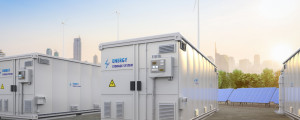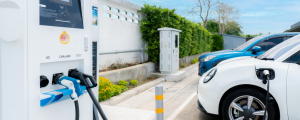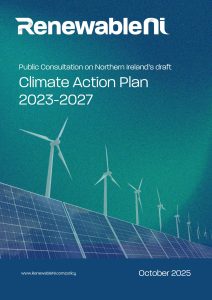The Public Consultation on Northern Ireland’s draft Climate Action Plan 2023-2027 closed on Wednesday 8 October. Policy Analyst Madeleine Clarke led the response from RenewableNI, and in this edition of Policy Unpacked looks at the role of renewables in the delivering our net zero future.
Northern Ireland is committed to achieving net zero carbon emissions by 2050. The Climate Change Act enshrines this in law. Northern Ireland’s first Climate Action Plan represents a vital step in plotting the pathway towards net zero. RenewableNI welcomes the measures laid out in Northern Ireland’s draft Climate Action Plan (CAP), covering the years 2023-2027, but plans alone will not deliver results. Timely delivery of these measures will be essential in meeting Northern Ireland’s climate targets.
The Energy Sector
The Climate Change Act committed Northern Ireland to achieving 80 per cent renewable electricity generation by 2030. The steps laid out in the CAP must be sufficient to meet this statutory target. Since 1990, there has been a 43.8 per cent decrease in carbon emissions from the energy sector. As pointed out in the CAP, the energy production and supply sector has made the largest contribution to the decrease of carbon emissions in Northern Ireland. Northern Ireland will need to push on and continue this progress to achieve the 80 by 30 target.
Renewable electricity support scheme
The Northern Ireland Renewables Obligation (NIRO) support scheme, open to new projects from 1 April 2005 to 31 March 2017, was crucial in increasing renewable energy generation from 3 per cent of Northern Ireland’s electricity mix to 46 per cent in 2020.
Since NIRO closed to new projects in 2017, renewables deployment has stalled. Only five new wind farms have been built this decade, adding just 156 MW of capacity compared to the 400 MW connected in 2016. Continuing support through the NIRO scheme for already accredited projects is important for maintaining their viability. To build new renewables on the scale necessary, a new support scheme – based on the Contracts for Difference (CfD) model – is urgently needed to revive investment in the renewables industry and achieve sufficient emissions reductions in the power sector.
The Department for the Economy (DfE) has committed to finalising the Renewable Electricity Price Guarantee (REPG) and revising grid connection policy, but the REPG design has only been published in September despite being expected in early 2025. Every delay erodes investor confidence and risks Northern Ireland falling further behind.
Grid infrastructure
Grid infrastructure is another critical bottleneck. Key enabling projects needed for 80 by 30 – such as the Northwest of NI 110kV Reinforcement and the Mid-Tyrone Project – have recently been pushed back by three and four years respectively, while the North Sperrins Generation Substation still lacks a firm delivery date. Many of these projects remain stuck in the planning system or have been beset by other delays, creating further uncertainty and delivery risk.
The North-South Interconnector, a vital project in reducing grid constraints and enabling more renewable electricity to be brought onto the system, has been similarly delayed.
Without accelerated delivery of both policy and infrastructure, the gap between commitments and delivery will widen, jeopardising the 2030 target.
The Planning System
The planning system will be crucial in delivering the 80 by 30 renewables target. Planning policy and planning decisions are vital in enabling the delivery of climate action, and specifically in enabling the deployment of renewable electricity and the expansion of key transmission and distribution infrastructure.
Unfortunately, there are significant problems in the planning system. As mentioned in the previous section, key grid infrastructure projects have been delayed several years by being stuck in the planning system.
On average, it is taking almost three years for decisions to be made on wind farm applications, well beyond the target of 30 weeks and the worst timeline in the UK and the Republic of Ireland. Furthermore, while the consultation on a revised Strategic Planning Policy Statement was closed in June 2023 and a paper in response to that consultation has been tabled multiple times at the Executive since September 2024, that paper has not yet been published.
Without an effective planning policy, Northern Ireland will not deploy enough renewables to achieve the 80 by 30 target and will not achieve the emissions reductions in the energy sector required in the Climate Action Plan.
Looking to the future
Though focussed on the key actions needed to deliver the 80 by 30 renewables target, to ultimately achieve net zero carbon emissions by 2050 Northern Ireland needs to start planning for the electricity system beyond 2030.
Nort hern Ireland will need to bring new and innovative technologies, specifically offshore wind (a mature technology but new to the region) and Long Duration Energy Storage (LDES). While these technologies will not be commissioned until 2030 or later, key actions need to be taken within this Climate Action Plan to enable that later deployment.
hern Ireland will need to bring new and innovative technologies, specifically offshore wind (a mature technology but new to the region) and Long Duration Energy Storage (LDES). While these technologies will not be commissioned until 2030 or later, key actions need to be taken within this Climate Action Plan to enable that later deployment.
SONI’s plans envisage the first LDES being commissioned in 2030. Achieving this requires co-ordination between government departments, SONI, NIE Networks, and the Utility Regulator. The assessment of non-fossil flexibility needs, the design of procurement mechanisms for LDES, and any required legislation must be progressed in tandem, or as close to in tandem as possible to achieve this timeline.
The Offshore Renewable Energy Action Plan (OREAP) envisages the first offshore wind projects being deployed in the early 2030s. Setting up a renewable electricity support scheme and passing the Offshore Renewable Energy Bill by the end of 2027 will be crucial in delivering offshore wind in the early 2030s.
A just transition
Enabling everyone in Northern Ireland, from all backgrounds, to benefit from the energy transition is important to maintaining public support and ensuring Northern Ireland maximises the benefits of the transition.
The CAP’s focus on affordability and fairness, and on placing consumers at the centre of the energy transition, is therefore very welcome. RenewableNI particularly supports the CAP’s focus on green skills and workforce development. Building a diverse and inclusive workforce (including bringing young people into the industry and reskilling workers from other sectors) will be incredibly important to renewable energy development.
Electrification
 As the voice of the renewable electricity industry in Northern Ireland, RenewableNI’s main focus is on the role of the energy sector in the Climate Action Plan.
As the voice of the renewable electricity industry in Northern Ireland, RenewableNI’s main focus is on the role of the energy sector in the Climate Action Plan.
The electrification of sectors such as heat and transport will be vital for their decarbonisation. Increased renewable electricity deployment will be needed to meet the demands of these sectors.
Although the CAP does include measures to increase the take up of electric vehicles and electric heat pumps, RenewableNI believes it would be worth stating clearly that electrification will be the main way these sectors achieve net zero emissions by 2050.
Given the current rate of deployment of these technologies, it is unlikely they will have a significant impact on electricity demand until the 2030s. This makes it more important to decarbonise the electricity system now so it is ready to support the decarbonisation of those industries later.
Northern Ireland has the renewable resources and the expertise to deliver on its climate commitments, both in this carbon budget period and beyond. Ambition must be matched with delivery.
That means clear policies, rapid timelines, and co-ordinated action. If these fundamentals are in place, the Climate Action Plan can unlock Northern Ireland’s clean energy future.
Ready To See What's Next?
Find out more about RenewableNI's Climate Action Plan response.
Contact Madeleine Clarke



